Keywords
|
| Ad-hoc networks, Cognitive radio, Mobility, Reactive routing protocol, AODV, DSR |
INTRODUCTION
|
| The main aim of Cognitive radio network technology is to improve the spectrum operation in the licensed frequencies, and also improve the congestion in the 2.4GHz ISM band. Recent research in this area has mainly focused on spectrum sensing and sharing issues in infrastructure-based networks that relies on the occurrence of a centralized entity for collecting the spectrum information, deciding the best possible spectrum for use, and allocating transmission schedules to the CR users served by it. Moreover, such architectures are generally single hop, with each CR directly communicating with the central entity as the end destination. Cognitive Radio Ad-Hoc Network (CRAHNs) is a new developed technology of wireless communication [1]. The difference to traditional wireless networks is that there is no need for established infrastructure. Since there is no such infrastructure and therefore no preinstalled routers which can, for example, forward packets from one host to another, this task has to be taken over by participants, also called mobile nodes, of the network. Each of those nodes takes equal roles, what means that all of them can operate as a host and as a router. Traditional wireless networks need some improvement due to some factors such as security, power control, and transmission quality and bandwidth optimization. This increased need for bandwidth in some frequency bands coupled with under utilization in other bands has covered the way towards Dynamic Spectrum Allocation (DSA) policies for the use of radio spectrum in wireless networking. In contrast to the legacy fixed spectrum allocation policies, DSA allows license exempt end–users to access the licensed spectrum bands when not in use by the licensed owners, also known as primary users (PU) of the bands. Dynamic Spectrum Allocation is expected to enable more efficient use of frequency channels without impacting the primary licensees. Thus the Federal Communications Commission (FCC) recently defined provisions to open the sub 900 MHz TV bands for unlicensed services, provided that the secondaries proactively detect the return of and avoid interruption to the primary users (PU). The newly proposed cognitive radio (CR) technology is predictable to make Dynamic Spectrum Allocation the reality. In its most general form, the Cognitive R was envisaged as an autonomous agent that perceives the user’s situation and proactively assists in performing some tasks. Ideally in our scenario, the nodes in a cognitive radio network (CRN) will not only search for spectrum holes and use them when needed, but also act intelligently with enough co-ordination to enhance the overall system performance of the entire network. We try to solve problems like maintenance and discovery of routes and topological changes of the network is the challenge of Ad-Hoc Networking [2]. |
| Several layers of the network protocol stack will need to be enhanced to accommodate the additional functionalities of Cognitive Radios. The physical (PHY) layer will need to sense for spectrum holes which is scanning the spectrum and processing wideband signals to continuously adapt its operating power, spectrum band and modulation without human interference. The medium access (MAC) layer must intelligently cooperate in sensing the spectrum and coordinate dynamic spectrum access [3]. Subsequently, the network layer must be aware of several parameters gathered in the MAC and PHY layers to perform spectrum-aware routing. Unlike infrastructure based networking, multi-hop point-to point architecture can create wide-area Cognitive Radio back-haul networks where traffic can flow among the peers directly using relay and forwarding via multiple hops resulting in higher capacity, ubiquitous connectivity and increased coverage. However, currently, there is little understanding on how such cognitive mesh architecture will operate so as to make the system feasible under Dynamic Spectrum Allocation (DSA). Accordingly, the issues in the design of multi-hop CRNs must be better studied for the concept of CRNs to reach its full potential. An example of multi-hop Cognitive Radio Network is shown in Fig. 1. |
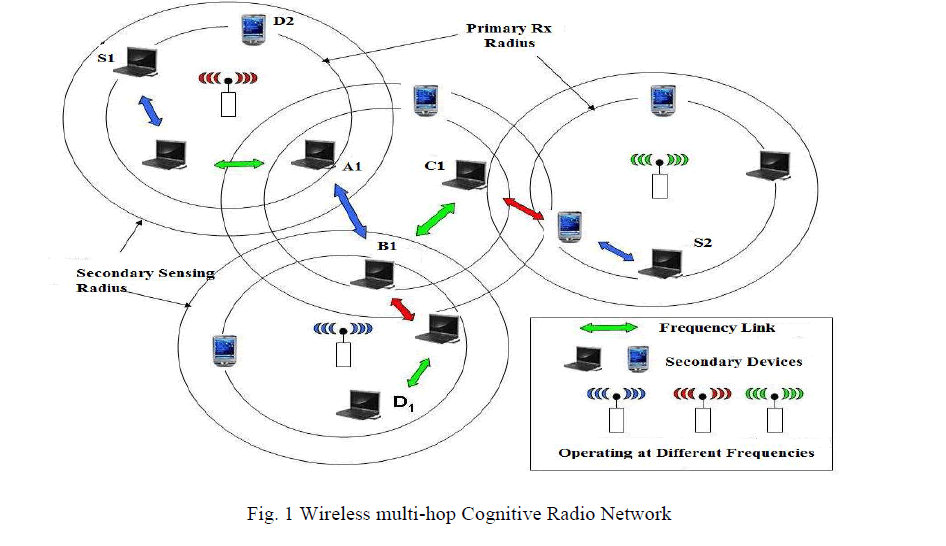 |
| In Dynamic Spectrum Allocation (DSA), is the ability to switch between multiple frequencies allows better spectrum efficiency, and also lower radio interference by simply switching to orthogonal frequency bands when needed. Hence a multi-hop Cognitive Radio Network can; |
| ïÃâ÷ increase efficient spectrum utilization, |
| ïÃâ÷ reduce interference among users, |
| ïÃâ÷ increase network throughput through usage of multiple simultaneous packet transmissions on different channels, |
| ïÃâ÷ increase ubiquitous connectivity and |
| ïÃâ÷ increase service area coverage. |
| When we are applying Cognitive Radio technology in wireless network improve the system capability and spectrum utilization efficiency. Incidentally, several routing protocols have been proposed for CRNs to deal with the inherent issues of these networks, which include opportunistically spectrum access, dynamic spectrum availability and interference protection towards primary user’s activity, multi-channels transmission and high energy consumption [4]. Never the less, due to unique network characteristics, it comes out with several significant challenges which need to be considered for routing design as follows: |
| Energy consumption: In some CNs, such as CR mobile ad hoc networks or CR sensor networks, SUs generally are small in size, and have limitation on energy capacity. However, sensor units must be capable of sensing the spectrum in a wide frequency band, so the efficient power control is required. Besides, the dynamic nature of channel availability in Cognitive Radio Networks (CRNs) can source energy consumption due to packet loss and retransmissions. As a result, the network partitioning problem may occur easily due to the energy exhaustion of the relay nodes. In such networks, routing protocol with energy awareness is challenging and should be taken into account [5]. |
| Different spectrum characteristics: In a practical CRNs, spectrum channels at each SU may have different channel properties, such as bandwidth, delay, loss rate, propagation characteristic, etc., as well as being available for unequal period of time. As a result, different channels may support different transmission ranges [5]. |
| Effect of spectrum handoff: The end-to-end route in CRNs may be composed of multiple hops which use different channels for data transmission according to the spectrum availability. Large numbers of spectrum handoff (the process for a SU to change its frequency of operation) caused by multi-channels transmission or route recovery process may lead to the increased end-to-end delay and high energy consumption [5]. |
| Interference impact: According to the principle of the CRNs, preferable routes should be selected with the minimum interference to the PU networks and the interference effect must keep below the acceptable threshold level. Furthermore, the interference among links that use the same channel should be taken into account as well. However, it is also difficult to determine the acceptable level of interference impact [4] [5]. |
| Route recovery mechanism: For general wireless networks, link failures may result from node mobility, node fault or link degradation. However, route breakages in CRNs can be also caused by PU activity. Different causes of link failure may need different route recovery mechanism to deal with, i.e. finding another detour route by using same channel or changing the spectrum channel by using same route. Therefore, a SU must identify the correct cause of link failure and select the suitable route recovery algorithm [4]. |
| Common control channel: SUs usually coordinate with each other by utilizing a common medium for spectrum related information exchange, known as a common control channel (CCC). A CCC in CRNs facilitates the neighbor discovery and helps in channel access negotiation as well as routing information updates. However, the additional control channel in each SU is likely to be harmful for energy-constrained CRNs due to extra overhead of CCC establishment [5]. |
| PU activity aware routing: The protocol is designed with a purpose to establish a transmission path which avoids regions of Primary user activity. The reason behind the design is to make routes less vulnerable to the impact of Primary user activity during data transmission. When a Primary user (PU) region is encountered, the path will enter into a detour to avoid the PU region [4] [5]. |
| Location-based routing: The protocol utilizes the location information of the nodes to transmit the routing messages to the desired regions that make most progress towards the destination rather than the entire network in order to reduce control overhead. To obtain the whole geographical topology of the network, each node will flood its location and ID to all nodes in the networks [5]. |
| Cluster-based routing: The protocol divides the network nodes into a number of clusters. The clustering algorithms can be categorized into two categories, i.e. clusters with or without cluster head. For the former category, the cluster head is elected for each cluster to help in the data transmission management and to maintain cluster membership information. The main aim of cluster-based routing is to increase network scalability, optimize the bandwidth usage, and balance the distribution of resources [5]. |
| Network topology change: The topological changes in cognitive radio networks occur primarily due to fluctuations of primary user (PU) activity and node mobility. When PU activity is detected, the SU must immediately vacate the channel which overlaps the PU’s transmission frequency in order not to cause a harmful interference to PUs. Therefore, the available channel set at each secondary user (SU) varies over time and location. |
| Multipath routing: The protocol allows the establishment of multiple alternative paths between sourcedestination pair in order to transmit multiple data streams simultaneously or be used for backup purpose. It is typically proposed to provide load balancing, increase the reliability of data transmission and maximize the utilization of network resources. |
| Reinforcement learning based routing: The protocol applies a reinforcement learning to form a route for data delivery. The reinforcement learning provides a framework of learning a control policy based on experiences and rewards [5]. |
| Mobility aware routing: The protocol is designed with an aim to support the mobile CRNs in which the nodes (SUs or PUs) are movable, i.e. the nodes are free to move at any time, towards any direction and at any speed, resulting in frequent link breakages. To deal with these challenged networks, the protocol may establish the reliable path containing maximum number of less mobile nodes, or provide the efficient route recovery mechanism [5]. |
| The rest of the paper is organized as follows. In Section II cognitive radio network and an elaborate discussion of the MAC and Network layer challenges in multi-hop CRN. In section III related work on cognitive radio network. Proposed work is discussed in Section IV. In Section V simulation setup and result is discussed and conclude in section VI. |
COGNITIVE RADIO NETWORKS VS. MULTI-CHANNEL AD-HOC NETWORKS
|
| Cognitive radio network is based on DSA allows unlicensed secondary users to share licensed spectrum in time and space variant approach with minimal interference to Primary users. Although the ability of multi-hop Cognitive radio networks to operate over multiple spectrum bands gives the impression that these CRNs are similar to established adhoc networks with multi-channel support, in reality, there are numerous features that make CRNs unique. We describe these below [3] [5] [6] [7] [8]: |
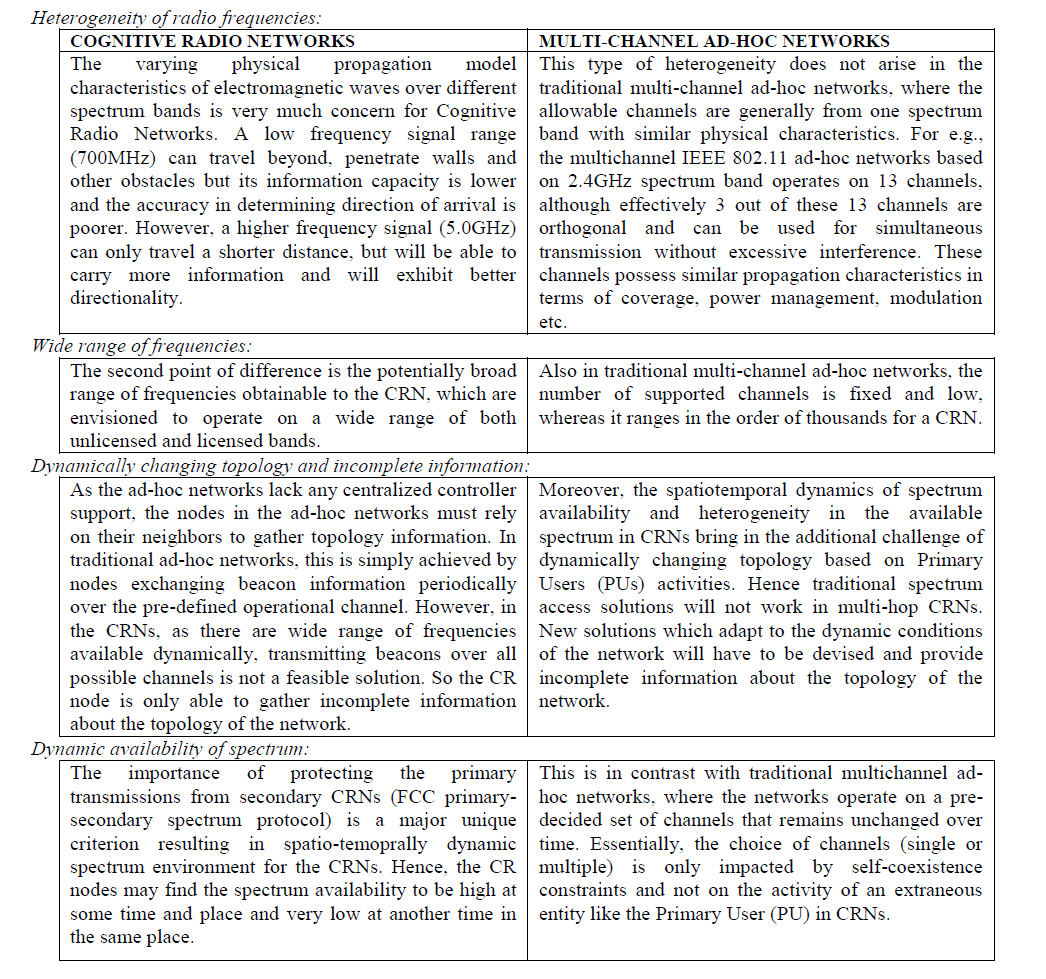 |
RELATED WORK
|
| Recent work in the area of distributed CR routing protocols has been describe for (i) networks with specific architectural assumptions (ii) general ad hoc networks and as follows: |
| Networks with specific architectural assumptions: |
| A path-centric spectrum assignment framework (Cognitive Radio Network) is proposed in that construct a multilayered graph of the network at each node such that the edge weights of the graph represent the spectrum availability between the nodes. In either case, a Dijsktra or Bellman Ford-like algorithm is run over the topology graph to find the optimal path. The dissemination of the network wide edge weights to each node incurs a prohibitive overhead, as is hence not suited for ad hoc network routing. Other works have also been proposed for mesh networks arranged in a tree hierarchy. Our work focuses on Cognitive Radio Network ad hoc networks, without assumptions of specific random network topologies, and where each user has limited knowledge of the location. Moreover, we believe that the consideration of the Primary user receivers, CR traffic classes and scalable routing approaches uniquely distinguish CRP from the other works in the literature [10]. |
| General ad hoc networks: |
| In the multi-hop single-transceiver CR routing protocol (MSCRP), analogous to the classical AODV, the RREQ is forwarded over all the possible channels to the destination. The latter then decides on the spectrum selection for the shortest path based on analytical estimates of the time for spectrum switching, channel contention, and data transmission. Similarly, the best routing paths are first identified and then the preferred channels along the path are chosen in. In these works, the sequential path selection and spectrum allocation does not guarantee that spectrum is available along the path optimized for classical metrics, such as latency or hop count. The CR users exchange their channel selection information periodically that also provides information of the extent to which the different classes of traffic (delay sensitive or otherwise) on a given channel is affected [11]. |
| CRP Routing Protocol Overview: |
| The route-setup in the CRP protocol is composed of two stages - (i) the spectrum selection stage, and the (ii) next hop selection stage. The source node broadcasts the RREQ over the control channel, and this packet is propagated to the destination. Each intermediate forwarder identifies the best possible spectrum band and the preferred channels within that band during spectrum selection. The spectrum selection is based on the connectivity edges between the two nodes; selection of route depends on less number of weights of edges with specific bandwidth. The several routing protocol plays the role for the cognitive ad hoc networks [12]. |
| A. AODV Protocol and Routing: |
| AODV [13] protocol is a routing protocol in a reactive routing protocol. Routing is only when needed. Fig.2 shows message transmission using AODV protocol. Routing in a Cognitive Radio Ad hoc Network (CRAHNs) is done with the goal of finding a short and optimized route from the source to the destination node. An advantage is that smaller bandwidth is needed for maintaining routing tables, and disadvantage is it will create non negligible delay, since before using the route for a specific communication, it has to be determined. When a source has to transmit to an unknown destination sends RREQ route request for the destination. If the receiving node has not received RREQ, it is not the destination node and does not have the current route to the destination. RREP of used for hopping purpose from the so use towards destination, it generates route reply (RREP).for the creation of routes between the nodes RREP is used. |
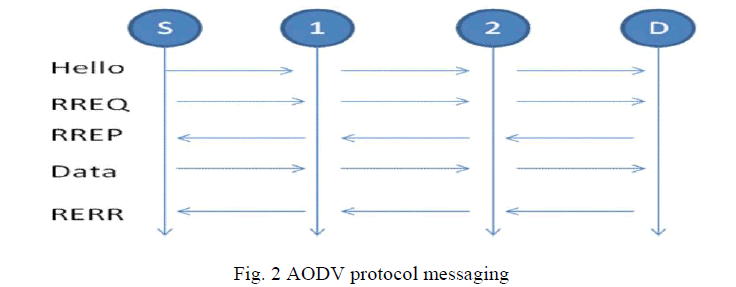 |
| Here the S is the source and D is the destination used for the transmission of simple message Hello towards destination D. When a route is needed and it is not already known by a node it sends a Route Request (RREQ) message to its neighbours. Those forward the message until it reaches the destination node. Each intermediate node updates the RREQ with its address. When a node sends a RREQ message it attaches to it a request ID. The request ID and the IP address of the node form a unique identifier. This is done in order to prevent that an intermediate node which receives twice the same RREQ message forwards it twice. When the destination receives the RREQ it sends a Route Reply (RREP) message back to the source node by reversing the hop sequence recorded in the RREQ. When the source receives the RREP it can start communicating with the destination, by including the whole route in the header of each to be sent message. |
| B. Dynamic MANET on-Demand Routing Protocol (DYMO): |
| Dynamic MANET On-demand (DYMO) [14] routing protocol enables reactive, multihop unicast routing between participating DYMO routers. DYMO is an enhanced version of AODV. DYMO operation is split into route discovery and route maintenance. Routes are discovered on-demand when the originator initiates hop-by-hop distribution of a RREQ (rout request) message throughout the network to find a route to the target, currently not in its routing table. This RREQ message is flooded in the network using broadcast and the packet reaches its target. The target then sent a RREP (route reply) to the originator. Upon receiving the RREP massage by the originator, routes have been established between the two nodes. For maintenance of routs which are in use, routers lengthen route lifetimes upon successfully forwarding a packet. In order to react to changes in the network topology, routers monitor links over which traffic is flowing. When a data packet is received for forwarding and a route for the destination route is broken, missing or unknown, then the source of the packet is notified by sending a RERR (route error) massage. Upon receiving the RERR massage, the source deletes that route. In future, it will need to perform route discovery again, if it receives a packet for forwarding to the same destination. DYMO uses sequence numbers to ensure loop freedom and enable them to determine the order of DYMO route discovery messages. |
| C. DYNAMIC SOURCE ROUTING PROTOCOL (DSR): |
| The key feature of DSR is the use of source routing. The source (sender) knows the complete hop-by-hop route to the destination. These routes are stored in a route cache. The data packets carry the source route in the packet header. It is an on-demand routing protocol and composed of two parts [14]: |
| 1. Route Discovery |
| When a node in the ad hoc network attempts to send a data packet to a destination for which route is not known, it uses a route discovery process to find a route. Route discovery uses simple flooding technique in the network with route request (RREQ) packets. Each node receiving an RREQ rebroadcasts it further, unless it is the destination or it has a route to the destination in its route cache. Such a node replies to the RREQ with a route reply (RREP) packet that is routed back to the original source. RREQ and RREP packets are also source routed. The RREQ builds up the path traversed so far. The RREP routes itself back to the source by traversing this path backward, the route carried back by the RREP packet is cached at the source for future use. |
| 2. Route Maintenance |
| The periodic routing updates are sent to all the nodes. If any link on a source route is broken, the source node is notified using a route error (RERR) packet. The source removes any route using this link from its cache. A new route discovery process must be initiated by the source if this route is still needed. Also, any forwarding node caches the source route in a packet it forwards for possible future use. Some of the techniques that are evolved to improve it are: Salvaging: An intermediate node can use an alternate route from its own cache, when a data packet meets failed link on its source route [15]. |
| Gratuitous route repair: a source node receiving a RERR packet piggybacks the RERR in the following RREQ. This helps cleaning up the caches of other nodes in the network that may have the failed link in one of the cached source routes [15]. |
PROPOSED WORK
|
| In the proposed work we describe the performance of routing protocol with the spectrum selection, route discovery and route maintenance in Network layer, for that we consider the number of nodes for the cognitive ad-hoc networks as the primary users (PUs). One of the nodes initially considers the source node which propagates the number of nodes after some interval of time in the wireless environment. Considering the five number of nodes for the implementation, which are connected for the communication with specific channel allocation from source node to the destination node. The route request RREQ is send initially from the source node & after confirmation the Destination node send the route reply RREP. If at the destination node if the problem create the destination send the RERR message to the source node i.e. the discarding of the packets. The following is the steps for the testing the simulation based on routing protocol. The following is the procedure which is considered as our initial implementation. |
| ïÃâ÷ Using AODV, DSR and DYMO routing protocol for the cognitive radio network data transmission |
| ïÃâ÷ Initialization of range selection. |
| ïÃâ÷ Creation of Cognitive radio nodes in wireless scenario for the next hop selection stage with route maintenance. |
| ïÃâ÷ Test the data rate transmission of a number of packets in the wireless cognitive network. |
| ïÃâ÷ Analysis average Jitter, Average End to End delay and Throughput of cognitive network with respect to No. of Nodes is to be finding out with graphs. |
| ïÃâ÷ Simulation of power analysis using routing protocol for the cognitive radio network data transmission in terms of power consumed in transmit, receive and ideal modes of above protocols with respect to No. of Nodes is to be finding out with graphs. |
SIMULATION SETUP & RESULT ANALYSIS
|
| Considering the Next hope selection stage in which the number of nodes as a cognitive node is 14. Here the number of nodes is 14 with number of packet Performance evolution of the AODV, DSR and DYMO protocol is implemented on the QualNet 5.0 with the following considerations. The following parameters are considered as shown in table 1[16] [17]. |
 |
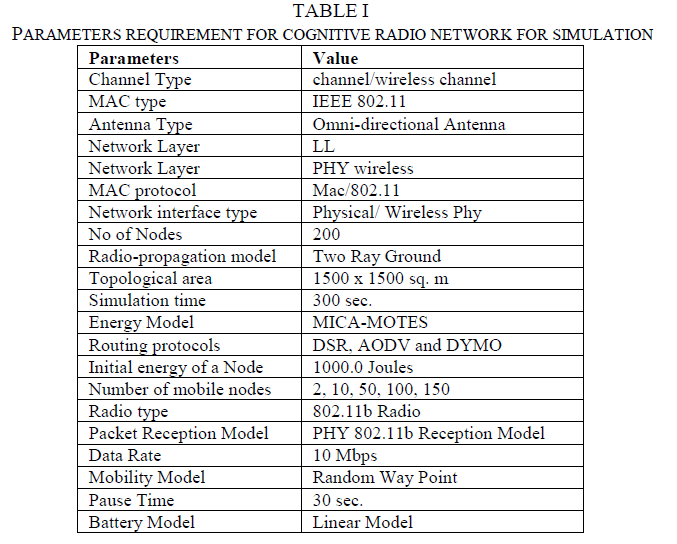 |
| The node is moving in the random motion in the area of 1500x1500 m2. When comes in specific transmission range it starts transmission between the different nodes. Here it is shown that the packet is transmitting. When overlapping of that & specific range is finish stops data transmission. The figure 4 showed the output. |
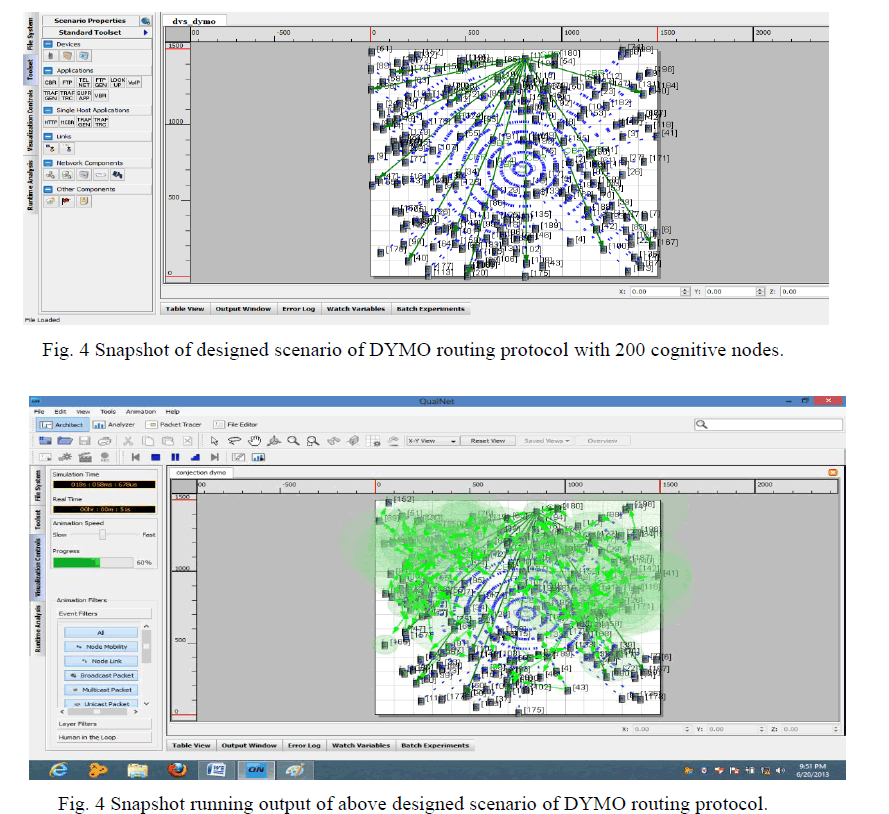 |
| Analysis of the cognitive wireless nodes: |
| One node sends the route request (RREQ) over AODV, DSR and DYMO routing protocols with TCP agents. While executing the output file the output generates as given below. One cognitive node starts communication with other node in Omni-directional way with specific time starts with 1.0ms & end with 7.0ms. There are five measurements in our experiments were defined as follows: |
| The simulation for reactive (on-demand) routing protocols is based on simulation time, number of node, area of network, pause time, routing protocols and speed of node. In our designed experimental methodologies performance matrix can be measured with variation in pause time while rest of all other parameters like simulation time, area of network, and speed of node kept constant. Effects of different parameter on performance of on-demand protocols are shown below. From simulation results in figures, it is observed that the performance of AODV protocol is better than other on-demand routing protocols (DSR and DYMO), because of the proper receiving of packets and less packet drop, but due to simulation results of End to End Delay with variation in pause time as shown in figures given below. |
| Average Jitter Effect: - Signifies the Packets from the source will reach the destination with different delays. A packet's delay varies with its location in the queues of the routers all along the path between source and destination and this position can vary randomly. It is observed that the performance of A O D V protocol is superior then DSR and DYMO. |
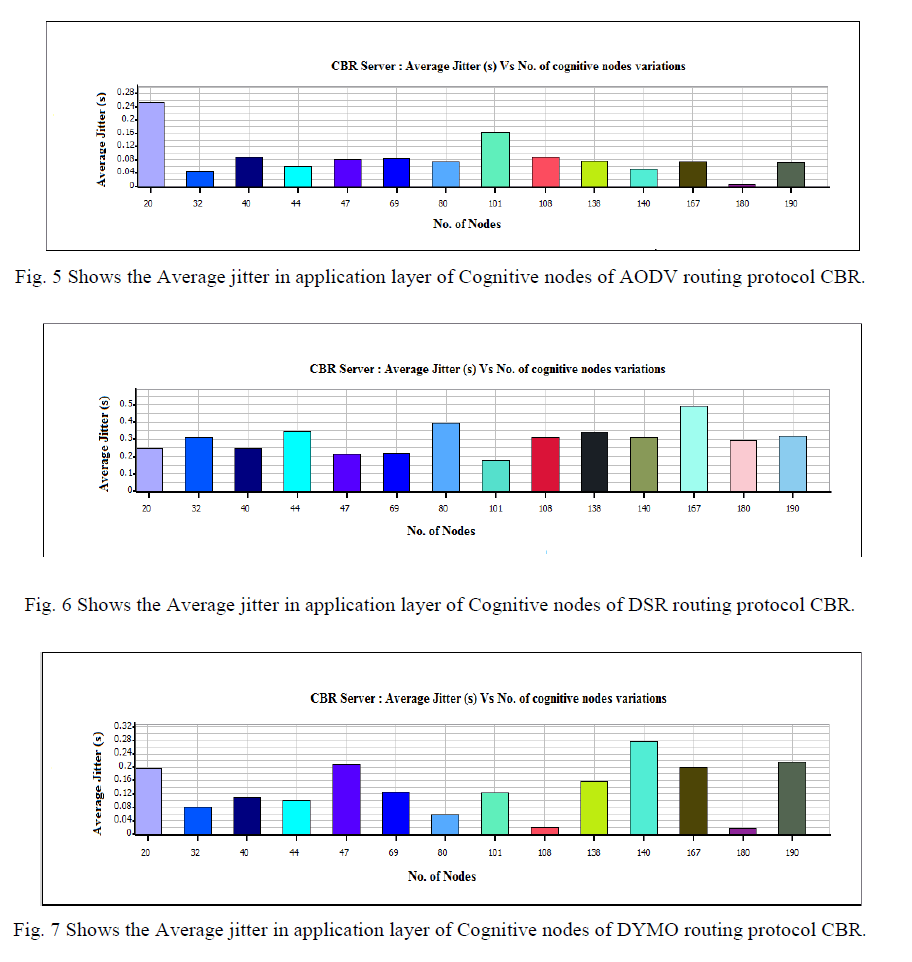 |
| End-To-End Delay: - Average End to End Delay signifies the average time taken by packets to reach one end to another end (Source node to Destination node). |
 |
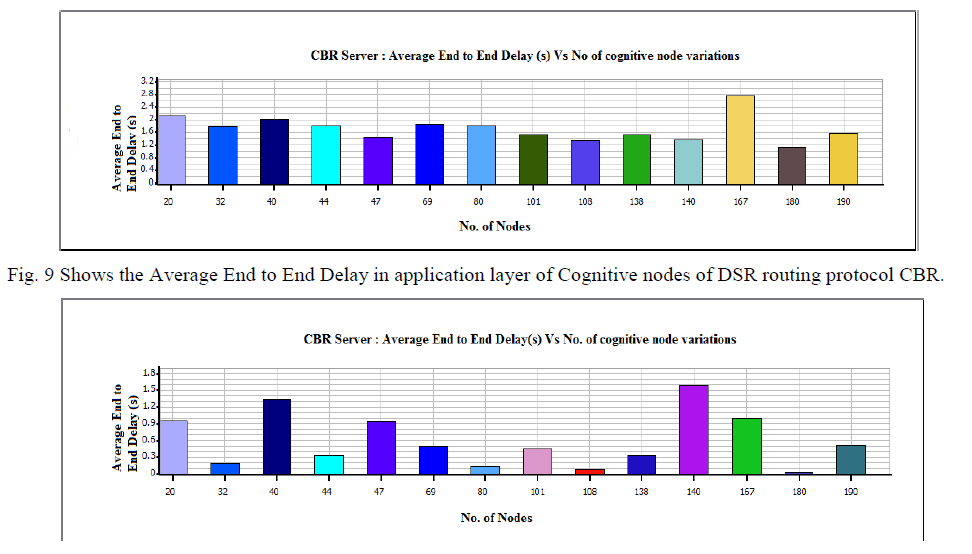 |
| Fig. 10 Shows the Average End to End Delay in application layer of Cognitive nodes of DYMO routing protocol CBR. |
| Throughput (bits/s):- Throughput is the measure of the number of packets successfully transmitted to their final destination per unit time. |
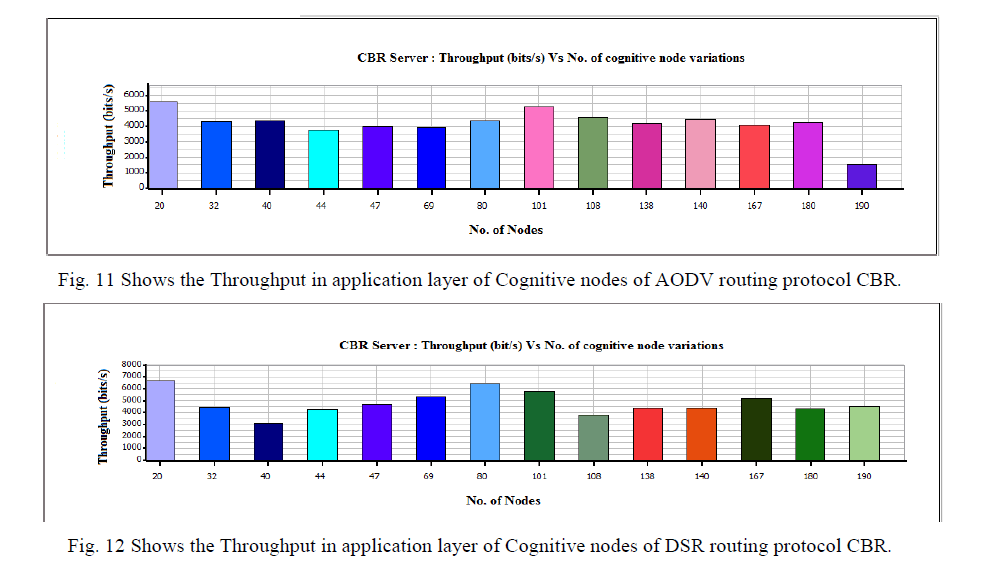 |
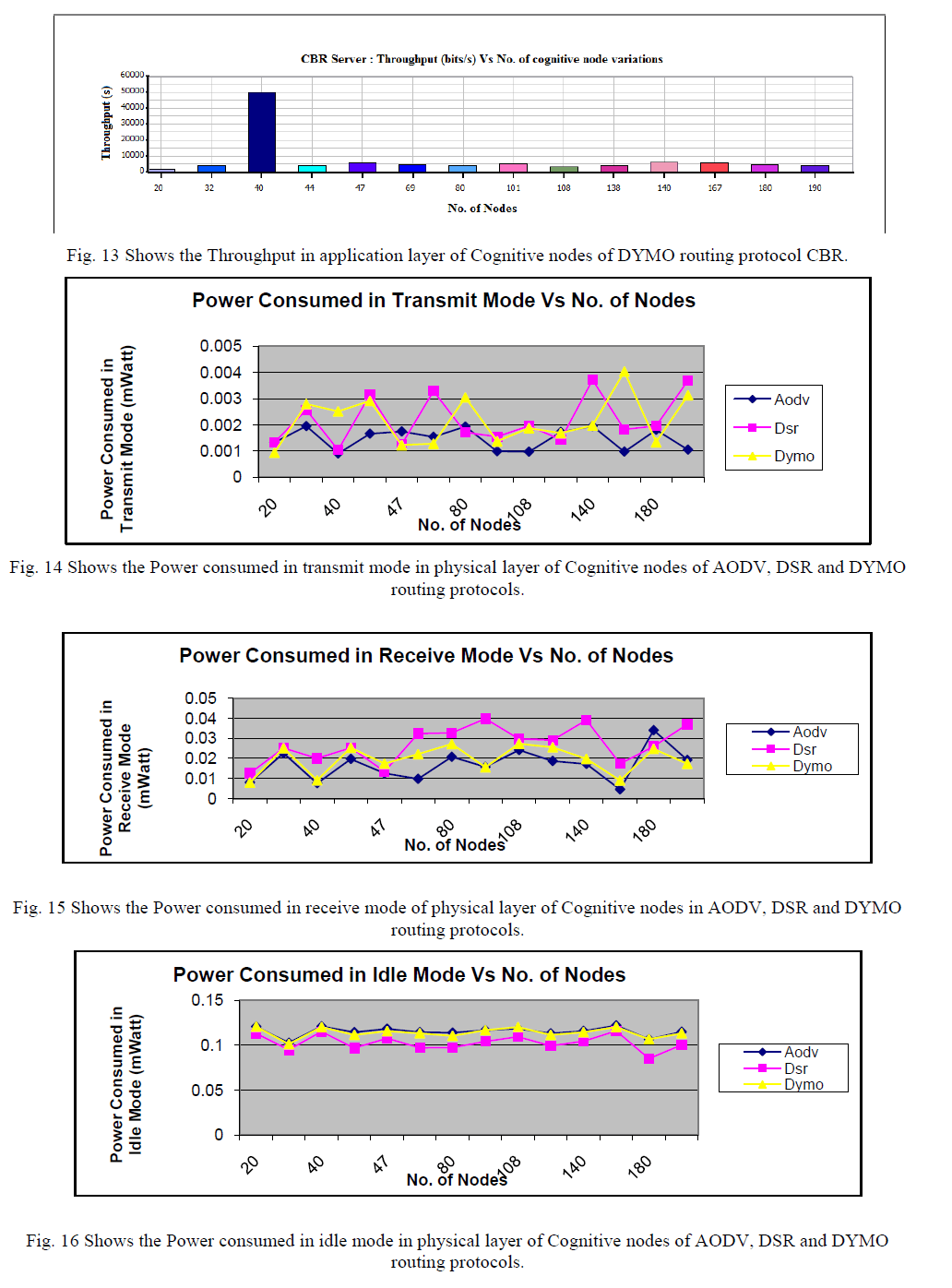 |
CONCLUSION
|
| The routing protocol AODV gives the better performance as the spectrum selection stage & the next hop selection stage. As shown above in the given graph implemented in the QualNet 5.0 the network simulating software. The AODV routing protocol is given the best performance regarding the packet transmission over the different channel in the cognitive radio ad hoc networks. The output shows that the average jitter, average end to end delay, throughput, energy consumed in received, transmit and ideal modes. The output shows the AODV is better than DSR and DYMO for the performance efficiency routing in Cognitive Radio Networks. Other interesting conclusion for routing protocols in Cognitive Radio Networks includes cross-layer routing design. By improving the efficiency of routing scheme, the cross-layer design may be required by utilizing the collaboration between routing and spectrum management in order to efficiently adapt to changes in radio interference, link quality, node density or network topology. |
| We strongly believe in future work that analyzing and criticizing the current routing techniques and their performance can expose new open issues and also be used to either enhance the existing routing schemes or to develop and design of optimal route selection for new routing solutions. |
References
|
- E. M. Royer and C. K. Toh, “A review of current routing protocols for ad hoc mobile wireless networks,” IEEE Personal Communications, vol.6, no. 2, pp. 46–55, 1999.
- Elizabeth M. Royer, C-K Toh, “A Review of Current Routing Protocols for Ad-Hoc Mobile Wireless Networks”, IEEE PersonalCommunications, April 1999, pp.46-55.
- K. L. A. Yau, P. Komisarczuk, and P. D. Teal, “Cognitive radio based wireless sensor networks: conceptual design and open issues,” inProceedings of the IEEE 34th Conference on Local Computer Networks (LCN ’09), pp. 955–962, October 2009.
- Q. Guan, F. R. Yu and S. Jiang, “Topology control and routing in cognitive radio mobile ad hoc networks,” Cognitive Radio Mobile Ad HocNetworks, in F. R. Yu (Ed.), Springer New York, pp. 209-225, 2011.
- N. Choi, M. Patel, and S. Venkatesan, “A full duplex multi-channel mac protocol for multi-hop cognitive radio networks,” InternationalConference on Cognitive Radio Oriented Wireless Networks and Communications, pp. 1–5, June 2006.
- M. Cesana, F. Cuomo, and E. Ekici, “Routing in cognitive radio networks: challenges and solutions,” Ad Hoc Networks, vol. 9, no. 3, pp.228–248, 2011.
- I. F. Akyildiz, W. Y. Lee, and K. R. Chowdhury, “CRAHNs: Cognitive Radio Ad Hoc Networks,” in Elsevier Ad Hoc Networks Journal, vol.7, no. 5, pp. 810-836, July 2009.
- H.-P. Shiang and M. vanderSchaar, “Delay-sensitive resource management in multi-hop cognitive radio networks”, in Proc. IEEE DySPAN,October 2008.
- ShubhangiMahamuni, Dr.Vivekanand Mishra, Dr.VijayM.Wadhai, “Performance Evaluation of AODV Routing Protocol in Cognitive RadioAd-hoc Network,” in International Journal of Wireless & Mobile Networks (IJWMN) Vol. 3, No. 5, October 2011.
- K. R. Chowdhury and M. D. Felice, “SEARCH: a routing protocol for mobile cognitive radio ad-hoc networks,” Computer Communications,vol. 32, no. 18, pp. 1983-1997, March-April, 2009.
- Y. Liu and D. Grace, "Improving Capacity for Wireless Ad Hoc Communications Using Cognitive Routing," presented at Crown Com 2008.3rd International Conference Singapore, 2008.
- D. Cavalcanti, S. Das, J. Wang, and K. Challapali, “Cognitive radio based wireless sensor networks,” in Proceedings of the 17th InternationalConference on Computer Communications and Networks (ICCCN ’08), pp. 491–496, August 2008.
- C. Perkins, E. Belding-Royer, and S. Das, Ad Hoc On-demand Distance Vector (AODV) Routing. The Internet Engineering Task Force(IETF), 2003, http://www.ietf.org/rfc/rfc3561.txt.
- D. Johnson, Y. Hu, and D. Maltz, 2004, The Dynamic Source Routing Protocol (DSR) for Mobile Ad Hoc Networks for IPv4. The InternetEngineering Task Force (IETF), 2004, http://www.ietf.org/rfc/rfc4728.txt.
- K. R. Chowdhury and I. F. Akyildiz, “OFDM based common control channel design for cognitive radio ad hoc networks,”IEEE Trans. MobileComputing., accepted for publication, 2010.
- Scalable Network Technologies, QualNet for Network design and Research, Online(2003) http://www.scalable-networks.com
- Qualnet, http://www.scalablenetworks.com
|